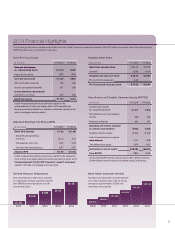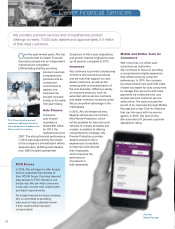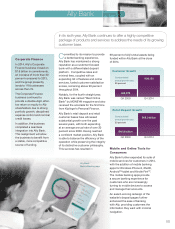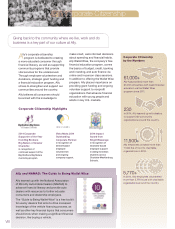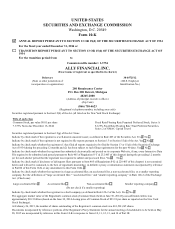Ally Bank 2014 Annual Report Download - page 17
Download and view the complete annual report
Please find page 17 of the 2014 Ally Bank annual report below. You can navigate through the pages in the report by either clicking on the pages listed below, or by using the keyword search tool below to find specific information within the annual report.
Table of Contents
Ally Financial Inc. • Form 10-K
5
• Source of Strength — Pursuant to the Federal Deposit Insurance Act, as amended by the Dodd-Frank Act, FRB policy and
regulations, and the Parent Company Agreement and the Capital and Liquidity Maintenance Agreement described in Note 21 to the
Consolidated Financial Statements, Ally is required to act as a source of financial and managerial strength to Ally Bank and is
required to commit necessary capital and liquidity to support Ally Bank. This support may be required at inopportune times for Ally.
• Enforcement Authority — The FDIC and FRB have broad authority to issue orders to banks and bank holding companies to cease
and desist from unsafe or unsound banking practices and from violations of laws, rules, regulations, or conditions imposed in
writing by the banking agencies. The FDIC and FRB also are empowered to require affirmative actions to correct any violation or
practice; issue administrative orders that can be judicially enforced; direct increases in capital; limit dividends and distributions;
restrict growth; assess civil money penalties against institutions or individuals who violate any laws, regulations, orders, or written
agreements with the banking agencies; order termination of certain activities of BHCs or their subsidiaries; remove officers and
directors; order divestiture of ownership or control of a nonbanking subsidiary by a BHC (in the case of the FRB); terminate deposit
insurance (in the case of the FDIC); and/or place a bank into receivership (in the case of the FDIC).
Basel Capital Frameworks
Until January 1, 2015, the U.S. risk-based and leverage capital standards applicable to Ally and Ally Bank were based on the Basel
Committee's Basel I capital accord (Basel I).
In December 2010, the Basel Committee reached an agreement on the Basel III capital framework, which was designed to increase the
quality and quantity of regulatory capital by introducing new risk-based and leverage capital standards. In July 2013, the U.S. banking
regulators finalized rules implementing the Basel III capital framework and related Dodd-Frank Act provisions (U.S. Basel III). U.S. Basel III
represents a substantial revision to the regulatory capital standards for U.S. banking organizations. Ally became subject to U.S. Basel III on
January 1, 2015. Certain aspects of the U.S. Basel III final rules, including the new capital buffers and regulatory capital deductions, will be
phased in over several years.
U.S. Basel III subjects Ally to a minimum Common Equity Tier 1 risk-based capital ratio of 4.5%, a minimum Tier 1 risk-based capital
ratio of 6%, and a minimum Total risk-based capital ratio of 8%. In addition to these minimum requirements, Ally will also be subject to a
Common Equity Tier 1 capital conservation buffer of more than 2.5%, subject to a phase-in from January 1, 2016 through December 31,
2018. Failure to maintain the full amount of the buffer will result in restrictions on Ally’s ability to make capital distributions, including
dividend payments and stock repurchases and redemptions, and to pay discretionary bonuses to executive officers. In addition to these new
risk-based capital standards, U.S. Basel III subjects all U.S. banking organizations, including Ally, to a minimum Tier 1 leverage ratio of 4%,
the denominator of which takes into account only on-balance sheet assets.
In addition to introducing new capital ratios, U.S. Basel III revises the eligibility criteria for regulatory capital instruments and provides
for the phase-out of existing capital instruments that do not satisfy the new criteria. Subject to certain exceptions (e.g., for certain debt or
equity issued to the U.S. government under the Emergency Economic Stabilization Act), trust preferred and other “hybrid” securities will be
phased out from a banking organization’s Tier 1 capital by January 1, 2016. Also, subject to a phase-in schedule, certain new items will be
deducted from Common Equity Tier 1 capital, and certain other deductions from regulatory capital will be modified. Among other things,
U.S. Basel III requires certain deferred tax assets (DTAs) that exceed specified individual and aggregate thresholds to be deducted from
Common Equity Tier 1 capital. U.S. Basel III also revises the U.S. Basel I-based standardized approach for calculating risk-weighted assets
by, among other things, modifying certain risk weights and introducing new methods for calculating risk-weighted assets for certain types of
assets and exposures. Ally is subject to the U.S. Basel III standardized approach for counterparty credit risk. It is not subject to the U.S. Basel
III advanced approaches for counterparty credit risk.
Ally is currently not subject to the U.S. market risk capital rule, which applies only to banking organizations with significant trading
assets and liabilities.
Depository Institutions
Ally Bank's deposits are insured by the FDIC, and Ally Bank is required to file periodic reports with the FDIC concerning its financial
condition. Total assets of Ally Bank were $104.5 billion and $98.7 billion at December 31, 2014 and 2013, respectively. As a commercial
nonmember bank chartered by the State of Utah, Ally Bank is subject to various regulatory capital adequacy requirements administered by
state and federal banking agencies. The Federal Deposit Insurance Corporation Improvement Act of 1991 (FDICIA), among other things,
identifies five capital categories for insured depository institutions ("well-capitalized," "adequately capitalized," "undercapitalized,"
"significantly undercapitalized," and "critically undercapitalized") and requires the respective federal regulatory agencies to implement
systems for "prompt corrective action" for insured depository institutions that do not meet minimum capital requirements within such
categories. Depending on the category in which an institution is classified, FDICIA imposes progressively more restrictive constraints on
operations, management, and capital distributions.
Failure to meet minimum capital requirements can initiate certain mandatory and discretionary actions by regulators that, if undertaken,
could have a direct material effect on Ally Bank's results of operations and financial condition. FDICIA generally prohibits a depository
institution from making any capital distribution, including payment of a cash dividend or paying any management fee to its holding company,
if the depository institution would become under-capitalized after such payment. Under-capitalized institutions are also subject to growth
limitations and are required by the appropriate federal banking agency to submit a capital restoration plan. If any depository institution
subsidiary of a holding company is required to submit a capital restoration plan, the holding company would be required to provide a limited


